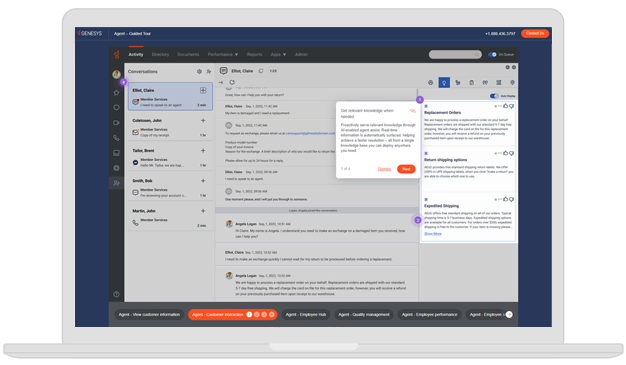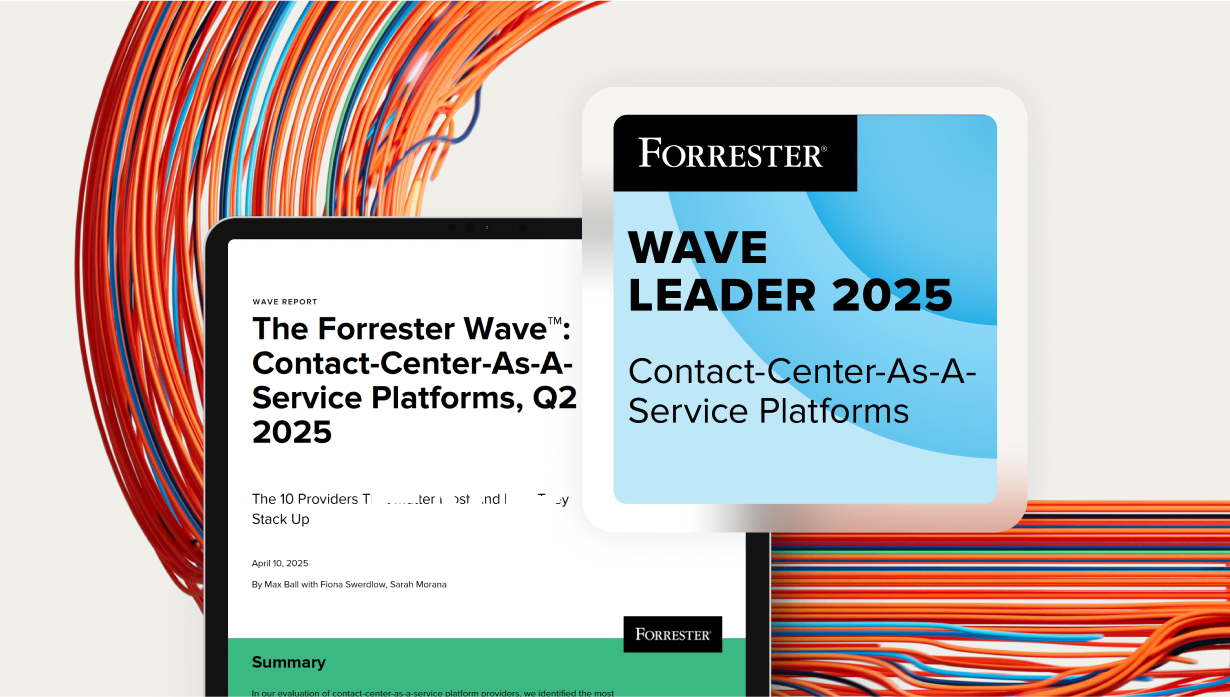
Managing schedules in a contact center isn’t as easy as simply drawing up who’s working when and then moving on to the next thing. It takes constant updating, tweaking and monitoring in real time to help ensure that the right people are in the right seats at the right time — all the time.
Focusing on the right management processes is an important part of making sure your workforce stays on track, both as individuals and as a team. Let’s take a look at two of those, how they synergize with each other, and what KPIs you should be looking at to enable optimal performance.
Understanding real-time adherence in workforce management
The first of these processes is real-time adherence. Here’s what that means, and how it affects your contact center specifically and your business as a whole.
What is real-time adherence (RTA)?
RTA allows contact center managers to track agent adherence to schedules in real time. Managers can monitor agent activity and performance metrics as they’re happening and make adjustments, as needed, to enable agents to meet service-level goals.
The importance of RTA for immediate response and flexibility
RTA allows supervisors to compare scheduled activity to actual activity and manage in the moment to help ensure what needs to be done is getting done. For example, if an agent is supposed to be working the phones but they’re taking an extra break instead, RTA allows that agent’s supervisor to see that as it happens, so they can check in with the agent and get them back on task and on schedule.
Organizations can also use RTA to identify trends and patterns in call center performance immediately, and to optimize staffing levels and resource allocation in the moment as needed. Call center managers can have better assurance that their operations are running efficiently and effectively, and that customer service levels are being maintained at all times.
How RTA tools enhance workforce efficiency and customer service
Contact center agents are human, and nobody’s going to perfectly adhere to a schedule. But RTA allows supervisors to limit inefficiency by bringing adherence as close to 95% as possible, by managing in the moment rather than having to circle back later and coach after the fact.
Holes in compliance get fixed faster, meaning there are more agents available — or, at least, the right number of agents — when they’re needed. And having agents available when they’re needed is the only way to help ensure that your customer service system operates at its full capacity, delivering the best possible customer experience.
Exploring intraday management for real-time workforce optimization
The other process is intraday management. Here’s what that means and how it can help contact center supervisors with real-time management.
What is intraday management?
Intraday management is the process of monitoring the current day’s interaction volume and usage and making adjustments to schedules based on changing needs.
Managing the unexpected: call volume spikes, absences, and more
No matter how thorough planners are in scheduling agents for a day’s work, things happen unexpectedly. An agent might have a personal emergency like a sick child or a plumbing mishap at home. Interactions might spike because an event occurs like a website crash or a product defect that gets announced. On the other hand, lower-than-usual volume might mean agents are stuck with nothing to do, wishing they hadn’t had to come in that day.
On days like these, intraday management is critical because it’s the only way to be sure of proper staffing.
Tools and techniques for effective intraday management
By combining technology with agile decision-making, contact centers can help maintain service quality and meet performance goals throughout the day. To be effective, leaders use tools like workforce management (WFM) systems and intraday dashboards to monitor call volumes, agent availability and service levels. Techniques such as dynamic scheduling, skill-based routing and real-time alerts help managers make quick adjustments. Regular communication with agents and supervisors also enables flexibility.
The synergy between RTA and intraday management
Real-time adherence and intraday management work together to enable contact center operations to run smoothly and efficiently throughout the day. RTA gathers data on what agents are doing and when. Intraday management uses this RTA data, along with other live metrics, including call volume, occupancy, interactions answered, abandon rates, average handle time, average speed to answer and service levels, to make informed decisions and adjustments during the day. For example, if too many agents are out of adherence during a call spike, managers can reassign tasks, adjust agent breaks or activate backup staff to maintain service quality.
Why RTA and intraday management work better together
Together, RTA and intraday management provide a complete picture of both individual agent performance and overall contact center operations. This combination allows for faster responses to unexpected changes, helping meet staffing requirements, performance targets and customer expectations alike in real time.
Key metrics to monitor with RTA and intraday management
As with any key contact center process, there are a number of KPIs you should track to help make sure you’re finding success with your efforts. Let’s examine a few and see how they match up to real-time adherence and intraday management.
Adherence rate and conformance
Adherence rate measures how closely agents stick to their scheduled activities in real time. For example, if an agent is scheduled to take calls from 9:00 to 11:00 but spends 10 minutes away from their phone without approval, their adherence rate drops. Conformance, on the other hand, measures whether agents are working the total number of hours they were scheduled, regardless of the exact timing of tasks.
These metrics directly support real-time adherence and intraday monitoring. RTA tracks adherence as it happens, allowing supervisors to intervene immediately if agents are off schedule. Intraday monitoring uses this live data, along with other performance indicators like service levels and call volumes, to adjust staffing or scheduling during the day.
Together, adherence rate and conformance help contact centers maintain productivity, meet SLAs and deliver consistent customer service. By combining these metrics with real-time and intraday tools, managers can respond quickly to changes and help ensure the right number of agents are doing the right work at the right time.
Schedule variance and shrinkage management
Schedule variance refers to the difference between the planned schedule and the actual hours worked by agents. This can include early logins, late logouts or unscheduled breaks, all of which can disrupt staffing plans. Shrinkage refers to the portion of time agents are being paid but unavailable to handle interactions. Not all shrinkage is negative — it can be due to factors as wide-ranging as training and meetings or absenteeism and unplanned breaks.
Real-time adherence tools help track schedule variance as it happens, alerting supervisors when agents are not following their assigned activities. This enables quick corrective actions to minimize service disruptions. Intraday monitoring uses schedule variance and shrinkage data to assess whether staffing levels align with actual contact volumes and to make on-the-fly adjustments such as rescheduling breaks or calling in additional support.
Managing variance and shrinkage in real time helps maintain service levels, improve forecasting accuracy and enable efficient use of resources. When integrated with intraday tools, these metrics provide a dynamic view of operations, allowing contact centers to stay responsive and agile throughout the day.
Recap of RTA and intraday management benefits
Real-time adherence and intraday monitoring offer major benefits for contact center performance and for workforce management. Real-time adherence helps ensure that agents follow their schedules as planned, alerting supervisors immediately when deviations occur. This allows for quick intervention to correct issues like extended breaks, unscheduled activities or agents in the wrong work state, helping maintain staffing balance and service consistency every moment of every day.
Intraday monitoring complements this by providing a broader, real-time view of contact center operations. It tracks key metrics such as call volume, average handle time, service levels and agent availability. With this information, managers can make informed decisions throughout the day — adjusting schedules, redistributing tasks and bringing in extra support as needed.
Together, these tools enhance operational agility, reduce the risk of overstaffing or understaffing, and help meet SLAs. They also improve agent accountability and engagement by reinforcing schedule adherence and performance expectations. Ultimately, the combined use of real-time adherence and intraday monitoring can lead to better customer experiences, increased efficiency and more consistent delivery of service goals across the contact center.
Moving forward with smarter workforce management
Smart workforce management helps ensure that the right people are doing the right work at the right times. Today, this is best done not with a pen and paper or even a spreadsheet. It’s done with contact center software that spans the whole operation, with artificial intelligence (AI) infused throughout. With AI-powered contact center software, real-time adherence is easier to track, and intraday management is much simpler.
Frequently asked questions
What are the key benefits of implementing RTA in a contact center?
Implementing real-time adherence in a contact center provides several key benefits. It helps ensure agents stick to their assigned schedules, improving overall efficiency and service consistency. RTA enables supervisors to spot and address adherence issues immediately, reducing downtime and staffing imbalances. It also supports better decision-making by providing live visibility into agent activity.
By promoting accountability and responsiveness, RTA contributes to meeting service level goals, enhancing customer satisfaction and optimizing workforce performance in a fast-paced, dynamic environment.
How does intraday management improve operational agility?
Intraday management improves operational agility in a contact center by enabling real-time adjustments to workforce plans based on current conditions. By continuously monitoring key metrics like call volume, agent availability and service levels, managers can quickly respond to unexpected changes such as spikes in demand or staffing gaps. This allows for on-the-fly decisions like rescheduling breaks, reallocating tasks or calling in backup staff. As a result, intraday management helps maintain service quality, reduce wait times, and enable efficient use of resources throughout the day.
What’s the difference between adherence and conformance?
In a contact center, adherence and conformance are both workforce management metrics, but they measure different things. Adherence tracks whether agents are following their assigned activities at the correct times — for example, being on a call when scheduled to take calls. Conformance measures whether agents work the total number of scheduled hours, regardless of the specific timing of tasks. An agent could have high conformance by working all assigned hours but low adherence if they frequently switch tasks or take breaks outside the planned schedule.
How can technology support RTA and intraday management?
Technology plays a vital role in supporting real-time adherence and intraday management in a contact center. Workforce management (WFM) systems and intraday dashboards provide live data on agent activity, schedule adherence, call volumes and service levels. These tools generate real-time alerts when agents deviate from their schedules or when service thresholds are at risk. Managers can use this information to quickly adjust staffing, reassign tasks and respond to unexpected changes.
By automating monitoring and providing actionable insights, technology enables faster, smarter decisions that help keep operations running smoothly.





